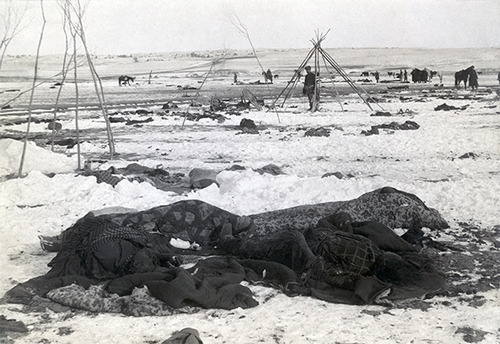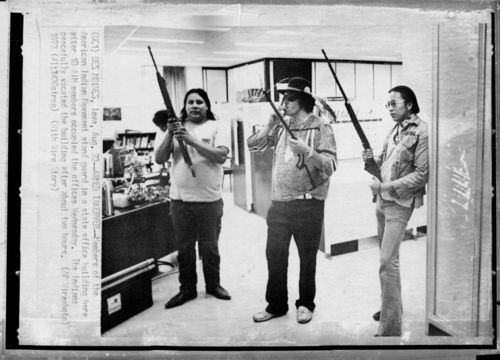#wounded knee
byJessica Mokrzycki,@AscendtheHills
Unrest is brewing once more at Wounded Knee, South Dakota, the infamous site of the last Indian Massacre in our nation’s history – a massacre that claimed the lives of approximately one hundred fifty Lakota men, women and children. This land is now up for sale and bids are already on the table from investors eager to make a profit while the Oglala Sioux Tribe, in a recent and unexpected course of action, has moved to seize the land using eminent domain (the power to take private property for public use by the state).
Unfortunately, many legal experts have doubts as to whether or not the Oglala Sioux Tribe will have grounds to use eminent domain in what has become a desperate and last-ditch attempt to save land that they, and many American Indians across the country, consider sacred.
According to an article in the Buffalo Post, speaking under the condition of anonymity, one top federal Indian law attorney in Washington D.C. expressed his grave doubts as to the projected outcome of such an endeavor.
“It would be very hard for me to see the tribe pull this off,” said the source. “If this was truly a viable option for tribes than it would be extremely easy for tribes to consolidate their land bases. They could simply seize whatever they wanted from non-members within the confines of the reservation, provided they pay just compensation. Who determines what just compensation is?”
The land’s owner, James Czywczynski, has invited Native residents to cast their own bids along with those of external investors. Such an offer seems hollow and callous, a gesture empty of any intentions to help Natives preserve the historic land that is within the confines of their reservation. Why so hollow a gesture? Because Czwczynski knows full well that the Tribe would never be able to afford to compete with the bids currently being considered. In 2010, the Oglala Sioux Pine Ridge Reservation was reported to have the lowest per capita income in the country with unemployment estimated at seventy percent.Czywczynski has expressed hopes that the Tribe would be able to acquire the land, but certainly profit is his main motivation as he is not willing to accept a price lower than the bids already presented and still rolling in. Cash is trumping any cultural investments for those with historical ties to the land.
Though the land has been appraised at $7,000, current Supreme Court case law has determined fair market value to be whatever a buyer would voluntarily pay for a designated property. Czywczynski currently has multiple buyers prepared to pay the $4.9 million asking price for the land.Czywczynski recently remarked that he is waiting for a specific buyer to purchase the land for the benefit of the tribe. “There are others that are waiting to buy this property, but I am waiting for this person who is buying it for the benefit of the tribe. I want the tribe to have this property,” he stated.
In a recent interview, Czywczynski explained how he had acquired Wounded Knee in the first place:
“The land was put up for sale in the 1930s as an allotment so the Native people could sell their land. The Oglala Sioux Pine Ridge Reservation was sold off, and there are many non-Indian ranchers, farmers, businessmen, cowboys and casinos that are owned and within the confines of that reservation.
“Our property was bought in the 1930s by Woodrow Wilson, who signed the deed. Clive Gildersleeve’s father bought the land and store in 1935, which included 40 acres of the national historical site of Wounded Knee. In 1968, I bought the property from the Gildersleeves, which included the Trading Post Museum, a home, four cabins and museum artifacts. The 40 acres we bought included the ravine and the area where the massacre took place in 1890.”
What Czywczynski is not mentioning is what really made the purchasing of the land possible and so inexpensive in the first place was the Dawes Act of 1887. The Dawes Act systematically reduced the land held by Natives in the West with an attempt to assimilate Indians into American society by undoing any notion of collective ownership and “giving” 160 acres to each head of household. The Dawes Act, however, exempted any “troublesome” tribes…one such tribe being the Lakotas. The Dawes Act left approximately 900,000 American Indians without any land to call their own.
Anger is surging throughout the Native population of the reservation. Many members fear that the land, if purchased by outsiders, will be turned into a tourist attraction and feel that the land inherently belongs to them.
“This is our backyard; this is our homeland,” said Garfield Steele, a tribal representative. “This has historical value for our people, not to any non-Indian. We will fight to keep it, as is, by all means.”
The outcome remains uncertain, but one can only hope that some measure will be taken to allow the Oglala Sioux Tribe to preserve a land holding so much significance to their heritage; a land that, for them, is simply priceless.Read more about this story at http://indiancountrytodaymedianetwork.com/2013/05/30/eminent-domain-and-horse-slaughterhouse-wounded-knee-149612
(DC1) DES MOINES, Iowa, Aug. 23—ARMED TAKEOVER—Members of the American Indian Movement stand guard in a state office building here after 10 AIM members occupied the offices Wednesday. The Indians peacefully vacated the building after two hours.
The American Indian Movement were a groundbreaking organization for indigenous rights, taking their inspiration from their contemporaries, the Black Panther Party. They boldly challenged the American power structure and demanded self-determination for their people and an end to the genocide they continue to face. Their history is a rich source of knowledge for us to take inspiration from, as well as learn from their mistakes.
Post link







